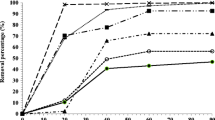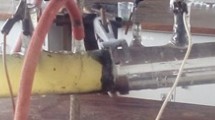Abstract
The goal of this research was to develop a new approach for tertiary water treatment, particularly disinfection and removal of refractory organic compounds, without adding any chemical. Hydrogen peroxide can indeed be produced from dissolved oxygen owing to electrochemical processes. Using various current intensities (1.0 to 4.0 A), it was possible to in situ produce relatively high concentration of H2O2 with a specific production rate of 0.05 × 10−5 M/min/A. Likewise, by using ultraviolet-visible absorption spectroscopy method, it was shown that other reactive oxygen species (ROS) including HO* radical and O3 could be simultaneously formed during electrolysis. The ROS concentration passed from 0.45 × 10−5 M after 20 min of electrolysis to a concentration of 2.87 × 10−5 M after 100 min of electrolysis. The disinfection and the organic matter removal were relatively high during the tertiary treatment of municipal and domestic wastewaters. More than 90 % of organic compounds (chemical oxygen demand) can be removed, whereas 99 % of faecal coliform abatement can be reached. Likewise, the process was also effective in removing turbidity (more than 90 % of turbidity was removed) so that the effluent became more and more transparent.









Similar content being viewed by others
Abbreviations
- CF:
-
Carbon felt
- GF:
-
Graphite felt
- COD:
-
Chemical oxygen demand
- RNO:
-
p-Nitrosodimethylaniline
- DWW:
-
Domestic wastewater
- MWW:
-
Municipal wastewater
- SS:
-
Suspended solids
- FC:
-
Faecal coliform
- C:
-
Concentration of RNO at time t
- C 0 :
-
Initial concentration of RNO
- k R :
-
RNO decomposition rate apparent constant
- N 0 :
-
Initial concentration of faecal coliform
- N t :
-
Concentration of faecal coliforms at time t
References
American Public Health Association (APHA) (1999) Standard methods for examination of water and wastewaters, 20th edn. American Public Health Association, Washington, DC
Bader H, Hoigné J (1981) Determination of ozone in water by the indigo method. Water Res 15(4):449–456
Brillas E, Boye B, Sirés I, Garrido JA, Rodriguez RM, Arias C, Cabot PL, Comninellis C (2004) Electrochemical destruction of chlorophenoxy herbicides by anodic oxidation and electro-Fenton using a boron-doped diamond electrode. Electrochim Acta 49:4487–4496
Cantrell CA, Shetter RE, Calvert JG (1995) Peroxy radical concentrations at several contrasting sites. J Atmos Sci 52:3408–3412
Comninellis C (1994) Electrocatalysis in the electrochemical conversion/combustion of organic pollutants for wastewater treatment. Electrochim Acta 39:1857–1862
Comninellis C, Pulgarin C (1991) Anodic oxidation of phenol for waste water treatment. J Appl Electrochem 21:703–708
Denny P (1997) Implementation of constructed wetlands in developing countries. Wat Sci Technol 35:27–34
Dirany A, Sirés I, Oturan N, Oturan MA (2010) Electrochemical abatement of the antibiotic sulfamethoxazole from water. Chemosphere 81:594–602
Drogui P, Elmaleh S, Rumeau M, Bernard C, Rambaud A (2001) Hydrogen peroxide production by water electrolysis: application to disinfection. J App Electrochem 31:877–882
Gandini D, Comninellis C, Belhadj Tahar N, Savall A (1998) Traitement électrochimique des eaux résiduaires chargées en matières organiques toxiques. Actual Chim 10:68–73
Gogate PR, Pandit AB (2004) A review of imperative technologies for wastewater treatment I: oxidation technologies at ambient conditions. Adv Environ Res 8:501–551
Grimm J, Bessarabov D, Sanderson R (1998) Electroassisted method for water purification. Desalination 115:285–294
Guinea E, Arias C, Cabot PL, Garrido JA, Rodriguez RM, Centellas F, Brillas E (2008) Mineralization of salicylic acid in acidic aqueous medium by electrochemical advanced oxidation processes using platinum and boron-doped diamond as anode and cathodically generated hydrogen peroxide. Water Res 42:499–511
Guinea E, Garrido JA, Rodriguez RM, Cabot PL, Arias C, Centellas F, Brillas E (2010) Degradation of the fluoroquinolone enrofloxacin by electrochemical advanced oxidation processes based on hydrogen peroxide electrogeneration. Electrochim Acta 55:2101–2115
Hamza M, Abdelhedi R, Brillas E, Sires I (2009) Comparative electrochemical degradation of the triphenylmethane dye methyl violet with boron-doped diamond and pt anodes. J Electroanal Chem 627:41–50
Ikehata K, El-Din MG (2006) Aqueous pesticide degradation by hydrogen peroxide/ultraviolet irradiation and Fenton-type advanced oxidation processes: a review. J Environ Eng Sci 5:81–135
Isarain-Chàvez E, Rodriguez RM, Cabot PL, Centellas F, Arias C, Garrido JA, Brillas E (2011) Degradation of pharmaceutical beta-blockers by electrochemical advanced oxidation processes using a flow plant with a solar compound parabolic collector. Wat Res 45:4119–4130
Jeong J, Kim JY, Yoon J (2009) The effect of electrode material on the generation of oxidants and microbial inactivation in the electrochemical disinfection processes. Water Res 43:895–901
Jiang YL, Liu HL, Wang QH, Jiang ZH (2006) Determination of hydroxyl radicals in TiO2/Ti photoelectrocatalytic oxidation system using Fe(phen)3 2+ spectrophotometry. J Environ Sci 18(1):158–161
Khataee AR, Safarpour M, Zarei M, Aber S (2011) Electrochemical generation of H2O2 using immobilized carbon nanotubes on graphite electrode fed with air: investigation of operational parameters. J Electroanal Chem 659:63–68
Konnerup D, Thammarat K, Brix H (2009) Treatment of domestic wastewater in tropical, subsurface flow constructed watlands planted with Canna and Heliconia. Ecol Eng 35:248–257
Kraft A, Stadelmann M, Wunsche M, Blaschke M (2006) Electrochemical ozone production using diamond anodes and a solid polymer electrolyte. Electrochem Comm 8:883–886
Kraljié I, Trumbore CN (1965) p-Nitrosodimethylaniline as an OH radical scavenger in radiation chemistry. J Am Chem Soc 87:2547–2550
Kuramitza H, Matsushitaa M, Tanaka S (2004) Electrochemical removal of bisphenol A based on the anodic polymerization using a column type carbon fiber electrode. Wat Res 38:2331–2338
Martinez-Huitle CA, Ferro S (2006) Electrochemical oxidation of organic pollutants for the wastewater treatment: direct and indirect processes. Chem Soc Rev 35:1324–1340
Muff J, Bennedsen LR, SØgaard EG (2011) Study of electrochemical bleaching of p-nitrosodimethylaniline and its role hydroxyl radical probe compound. J Appl Electrochem 41(5):599–607
Onda K, Ohba T, Kusunoki H, Takezawa S, Sunakawa D, Araki T (2005) Improving characteristics of ozone water production with multilayer electrodes and operating conditions in a polymer electrolyte water electrolysis cell. J Electrochem Soc 152:177–183
Oturan N, Wu J, Zhang H, Sharma V, Oturan MA (2013) Electrocatalytic destruction of the antibiotic tetracycline in aqueous medium by electrochemical advanced oxidation processes: effect of electrode materials. Appl Catal, B 140–141:92–97
Ozcan AS, Erdem B, Ozcan A (2004) Adsorption of acid blue 193 from aqueous solutions onto Na-bentonite and DTMA-bentonite. J Coll Inter Sci 280:44–54
Panakoulias T, Kalatzis P, Kalderis D, Katsaounis A (2010) Electrochemical degradation of reactive red 120 using DSA and BDD anodes. J Appl Electrochem 40:1759–1765
Panizza M, Cerisola G (2004) Electrochemical oxidation as a final treatment of synthetic tannery wastewater. Environ Sci Technol 38:5470–5475
Panizza M, Bocca C, Cerisola G (2000) Electrochemical treatment of wastewater containing polyaromatic organic pollutants. Wat Res 34:2601–2605
Peralta-Hernàndez JM, Meas-Vong Y, Rodriguez FJ, Chapman TW, Maldonado MI, Godinez LA (2006) In situ electrochemical and photo-electrochemical generation of the Fenton reagent: a potentially important new water treatment technology. Wat Res 40:1754–1762
Pozzo AD, Merli C, Sirés I, Garrido JA, Rodriguez RM, Brillas E (2005) Removal of the herbicide amitrole from water by anodic oxidation and electro-Fenton. Environ Chem Lett 3:7–11
Pulgarin C, Adler N, Peringer P, Comninellis C (1994) Electrochemical detoxification of a 1,4-benzoquinone solution in wastewater treatment. Wat Res 28(4):887–893
Rajeshwar K, Ibanez J (1995) Electrochemical aspects of photocatalysis: application to detoxification and disinfection scenarios. J Chem Educ 72:1044–1049
Rajeshwar K, Ibanez J (1997) Environmental electrochemistry—fundamentals and applications in pollution abatement. Academic Press, San Diego
Rajkumar D, Palanivelu K, Mohan N (2003) Electrochemical degradation of resorcinol using mixed metal oxide coated titanium for waste water treatment—a kinetic study. Ind J Chem Technol 10:396–401
Sigler PB, Masters BJ (1957) The hydrogen peroxide-induced Ce (III)-Ce(IV) exchange system. J Am Chem Soc 79:6353–6357
Simonsen ME, Muff J, Bennedsen LR, Kowalski KP, SØgaard EG (2010) Photocatalytic bleaching of p-nitrosodimethylaniline and a comparison to the performance of other AOP technologies. J Photochem Photobiol, A 216:244–249
Sirés I, Oturan N, Oturan MA, Rodriguez RM, Garrido JA, Brillas E (2007) Electro-Fenton degradation of antimicrobials triclosan and triclocarban. Electrochim Acta 52:5493–5503
Stucki K (1991) Electrohemical waste water treatment using high overvoltage anodes part II: anode performance and applications. J Appl Electrochem 21:99–104
Tahir SS, Rauf N (2006) Removal of a cationic dye from aqueous solutions by adsorption onto bentonite clay. Chemosphere 63:1842–1848
Vlyssides AG, Karlis PK, Rori N, Zorpas AA (2002) Electrochemical treatment in relation to pH of domestic wastewater using Ti/Pt electrodes. J Hazard Mater B95:215–226
Wang A, Qu J, Ru J, Liu H, Ge J (2005) Mineralization of an azo dye Acid Red 14 by electro-Fenton’s reagent using an activated carbon fiber cathode. Dyes Pigm 65:227–233
Xiang Q, Yu J, Wong PK (2011) Quantitative characterization of hydroxyl radicals produced by various photocatalysts. J Coll Inter Sci 357(1):163–167
Yue J, Epstein AJ, MacDiarmid AG (1999) Sulfonic acid ring-substituted. Substitute polyaniline, a self-doped conducting polymer. Molecular crystals and liquid. Ann Techn Conf(ANTEC) 99:1560–1562
Zang L, Qu P, Zhao J, Shen T, Hidaka H (1997) Photocatalytic bleaching of p-nitrosodimethylaniline in TiO2 aqueous suspensions: a kinetic treatment involving some primary events photoinduced on the particle surface. J Mol Catal A: Chem 120(1–3):235–245
Zaviska F, Drogui P, Blais JF, Mercier G, Lafrance P (2011) Experimental design methodology applied to electrochemical oxidation of the herbicide atrazine using Ti/IrO2 and Ti/SnO2 circular anode electrodes. J Hazard Mater 185:1499–1507
Zaviska F, Drogui P, Blais JF, Mercier G (2012) Electrochemical treatment of bisphenol A using response surface methodology. J Appl Electrochem 42(2):95–109
Zhang X, Fu J, Zhang Y, Lecheng L (2008) A nitrogen functionalized carbon nanotube cathode for highly efficient electrocatalytic generation of H2O2 in electro-Fenton system. Sep Purif Technol 64:116–123
Zhao X, Zhang B, Liu H, Chen F, Li A, Qu J (2012) Transformation characteristics of refractory pollutants in plugboard wastewater by an optimal electrocoagulation and electro-Fenton process. Chemosphere 87:631–636
Zhou M, Yu Q, Lei L (2008) The preparation and characterization of a graphite-PTFE cathode system for the decolorization of C.I. Acid Red 2. Dye Pigment 77:129–136
Acknowledgements
Sincere thanks are extended to the National Sciences, Engineering Research Council of Canada and Premier Tech Ltée for their financial to this study.
Author information
Authors and Affiliations
Corresponding author
Additional information
Responsible editor: Bingcai Pan
Electronic supplementary material
Below is the link to the electronic supplementary material.
Fig. SM1
Influence of recycling flow rate on hydrogen peroxide production; CF cathode electrode; I = 3.0 A (DOCX 46 kb)
Fig. SM2
Kinetic study of bleaching of RNO using CF cathode electrode; I = 1.0A; Q R = 2.0 L min−1 (DOCX 31 kb)
Fig. SM3
Turbidity removal (municipal wastewater effluent); 12.7 ± 0.2 NTU initial turbidity; CF cathode electrode; Q R = 2.0 L min−1 (DOCX 51 kb)
Fig. SM4
Turbidity removal (domestic wastewater effluent); 52 ± 3 NTU initial turbidity; CF cathode electrode; Q R = 2.0 L min−1 (DOCX 52 kb)
Rights and permissions
About this article
Cite this article
Guitaya, L., Drogui, P. & Blais, J.F. In situ reactive oxygen species production for tertiary wastewater treatment. Environ Sci Pollut Res 22, 7025–7036 (2015). https://doi.org/10.1007/s11356-014-3907-3
Received:
Accepted:
Published:
Issue Date:
DOI: https://doi.org/10.1007/s11356-014-3907-3




